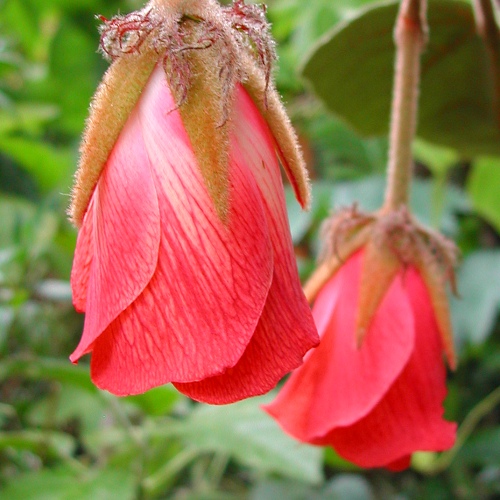Growing the seeds
Plant your seeds promptly for best germination Getting started -- Start by rolling the sides the seeds a few times over sandpaper or a nail file, to help water enter easier. Then soak them in a cup of water for 1-2 days (not more than 2 days). Use small containers or cups that have drainage holes. For soil, use a well draining soil mix, such as 2 parts potting soil to 1 part perlite or coarse sand. An alternate mix is equal parts of perlite and coir fiber, with some granular fertilizer mixed in. Fill each container with soil, but don't pack it down, place a seed on top, cover with 1/4 inch (5 mm) of soil, and add water until it's evenly moist, but not fully saturated. Until the seeds sprout, ensure that the soil surface stays moist. If you enclose the pots in a plastic dome or bag to maintain moisture, leave it open slightly to allow fresh air in. Keep the pots between about 65-77 degrees F (18-25°C), and below 60°F (15°C) at night, but above freezing. Avoid letting them get above 80°F (27°C) for prolonged periods. I recommend placing a minimum/maximum thermometer next to the pots. The seeds should begin sprouting within 8 weeks, but may take up to 12 weeks to start. Give your seedlings bright light, but avoid direct sunlight the first month. A bright LED or fluorescent bulb kept 4 inches (10 cm) from the plants provides the right amount of light the first month (See: "Growing indoors with LED lights"). After 1 month, you can give some morning sun, and increase the sun a little every 2-3 weeks. I recommend growing them indoors the first few months. Watering - Keep the soil evenly moist most of the time - but not constantly saturated. Don't let the soil dry out. Feeding - The first 2 months, feed every 7 days with a small amount of dilute (1/8 strength) liquid fertilizer. Hydroponic fertilizer is ideal for seedlings, because it is easily absorbed and contains all essential nutrients. After 2 months, you may switch to granular fertilizer that contains micronutrients. Or continue feeding weekly with liquid fertilizer at 1/8 strength. Repotting - When the plants are 2-3 months old, transplant them to a larger container. Transplant carefully to avoid letting the soil ball break apart, which can damage the roots. Watering the soil before repotting will help avoid this. For the first week after repotting, give no direct sun. Climate - It comes from a climate that is mild all year, with cool nights. In cultivation it has handled 90 degrees F (32 degrees C) with cool nights (below 65 F / 19 C). It's possible that it won't thrive with the combination of hot days and warm nights. My guess is that it's cold hardy to about 28 degrees F (-2 C). I recommend protecting it from frost. Over about 40% humidity is best. It likes mostly sunny conditions. In hotter climates, give the plants afternoon shade, especially while young. If you find that the leaves wilt despite the soil being moist, move it into more shade for a while until the root system grows larger. Pests to watch for - I've never seen insects on it, but watch for any pests that affect your other plants. Be careful when choosing chemical remedies, as some may harm the plant. If you have questions, feel free to contact me. Have fun growing them! - Jeff Strange Wonderful Things
|
|||||||||


